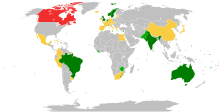|
Master Nationality Rule
 The Master Nationality Rule is a consequence of Article 4 of the Convention on Certain Questions Relating to the Conflict of Nationality Laws of 1930, a treaty ratified by twenty-three parties.[1] This provides that "a State may not afford diplomatic protection to one of its nationals against a state whose nationality such person also possesses".[2] In terms of practical effect, it means that when a multiple citizen is in the country of one of their nationalities, that country has the right to treat that person as if they were solely a citizen or national of that country. This includes the right to impose military service obligations or require an exit permit to leave.[3] Professor Eileen Denza states that the rule is a codification of a "classic rule" and, as of 2018, remains "modern state practice" internationally. The International Law Commission's 2006 draft Articles on Diplomatic Protection generally reaffirmed the rule.[4] Detailed explanationThe United Kingdom Home Office gave a detailed explanation of the rule:
The United Kingdom Foreign Office restated this in its advice to dual citizens abroad, stating it "would not normally offer you support or get involved in dealings between you and the authorities of that state."[6] The United Kingdom may still make informal diplomatic representations to the authorities of another country when a British citizen is held in another country, even if that person is also a citizen of that country, in case of special humanitarian needs,[7] such as the intervention made by then UK foreign secretary Philip Hammond during the Causeway Bay Books Disappearances. HistoryDuring the Cold War era, the United States signed consular agreements with certain Warsaw Pact countries providing that a U.S. citizen who entered that country with a U.S. passport and the appropriate visa would not be subsequently treated as a citizen of that country (and hence prevented from leaving).[8] The Warsaw Pact countries involved (notably Poland) wished to encourage tourism from emigrants and their descendants settled in the U.S. Since the dissolution of the Warsaw Pact in 1991, many of those countries have abolished visa requirements for U.S. citizens thus nullifying those provisions (for detailed discussion see under Dual citizenship in Poland). Australia,[citation needed] Canada,[9] and the United States[10] have concluded similar consular agreements with the People's Republic of China. In 2006, the International Law Commission adopted draft Articles on Diplomatic Protection, largely codifying established practice, which in general reaffirmed the rule. However it sought to ease the strictness of traditional practice with a proposal that where the nationality of a protecting state is "predominant", diplomatic protection may be given. These draft Articles have not been submitted to a conference to formalize them into a treaty. The draft Article 7 states:[4]
Eileen Denza, Professor of International Law at University College London and a former Legal Adviser in the Foreign and Commonwealth Office, states that the rule is a codification of a "classic rule", and as of 2018, remains "modern state practice" internationally.[4][12][13] James Larry Taulbee and Gerhard von Glahn, in their 2022 U.S. legal textbook, write that regarding the underlying Articles 3 to 6 of the Convention on Certain Questions Relating to the Conflict of Nationality: "states today in practice follow almost all of those provisions, despite the absence of general conventional rules." They do not use the name "Master Nationality Rule", but explicitly give a summary of the rule.[14] References
|